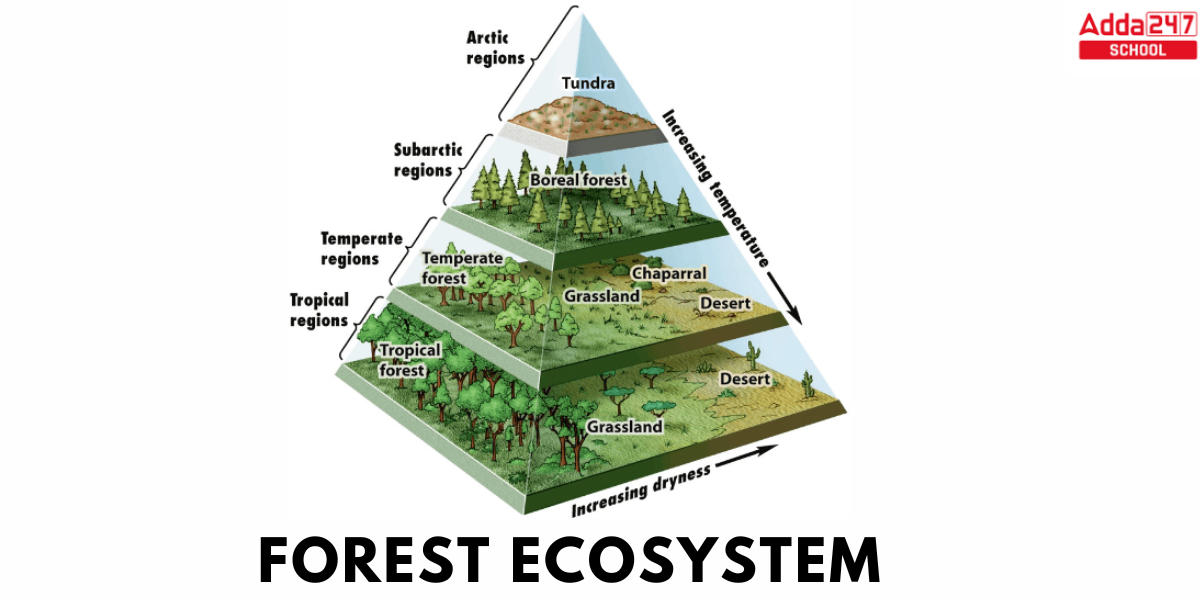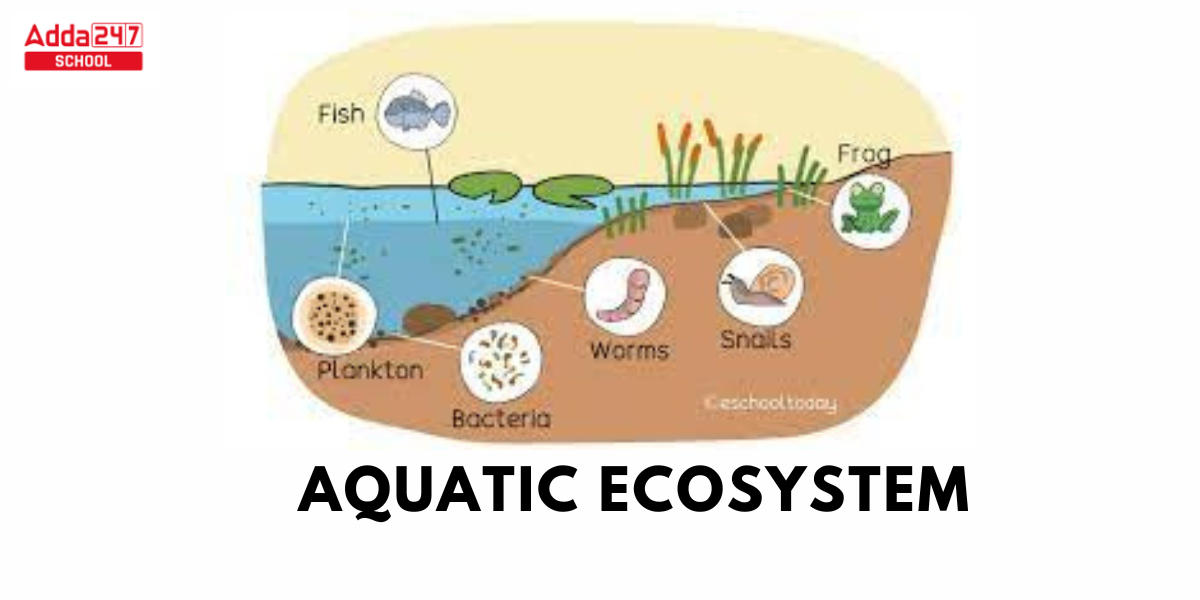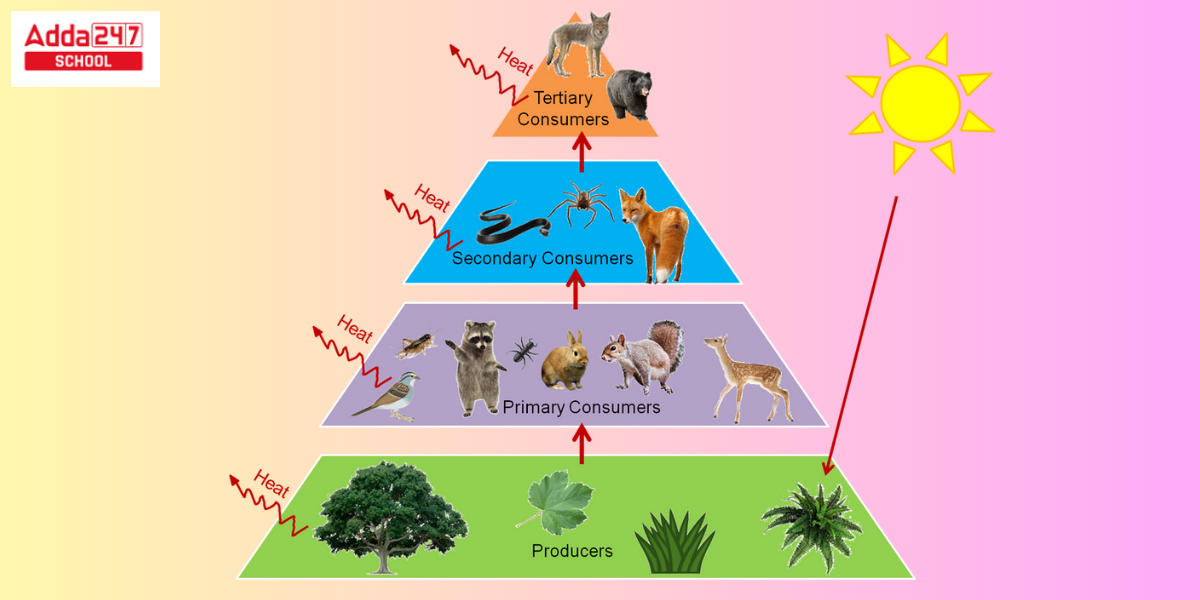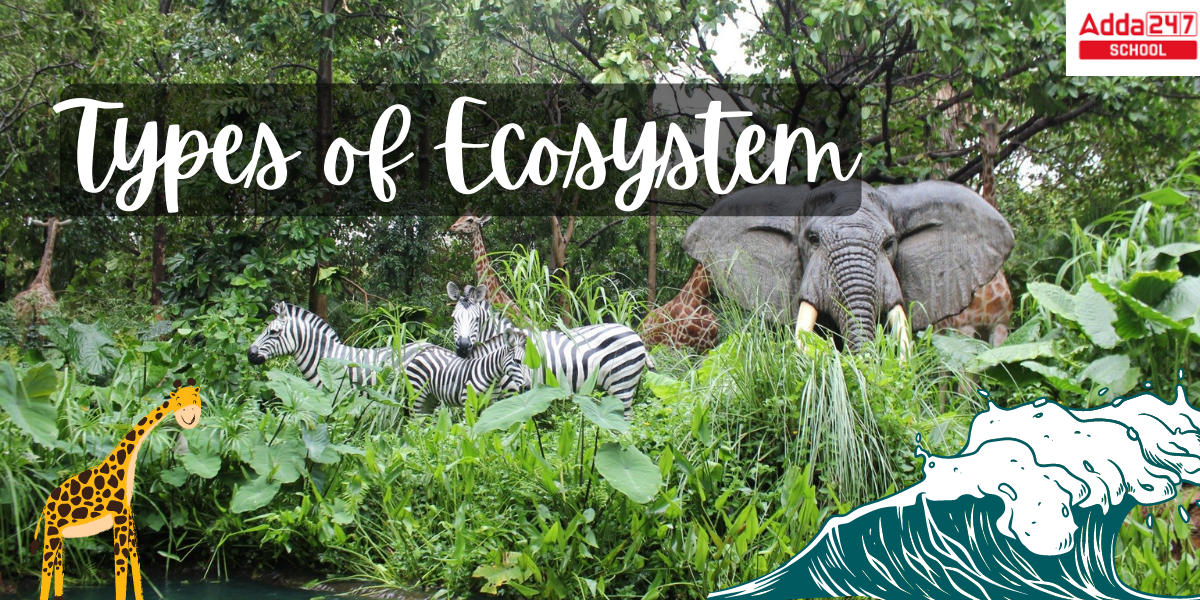The ecosystem definition is that it is a geographical area in which plants, animals, and other species, as well as weather and topography, interact to generate a living bubble. Ecosystems comprise both biotic and abiotic elements. Plants, animals, and other species are biotic factors, while rocks, temperature, and humidity are examples of abiotic factors in an ecosystem. Ecosystem: Interdependency
Ecosystem
Every part of an ecosystem is reliant on every other factor, whether directly or indirectly. A shift in an ecosystem’s temperature, for example, can have an impact on the plants that thrive there. Animals that rely on plants for food and shelter will need to adapt or migrate to a different ecology.
Ecosystems can range in size from enormous to small. Tide pools, or ponds left behind by the ocean as the tide recedes, are miniature ecosystems in themselves. Seaweed, a type of algae that produces food through photosynthesis, can be found in tide pools. Seaweed is eaten by herbivores like abalone. Other species in the tidal pool, such as clams or mussels, are eaten by carnivores like sea stars. The shifting level of ocean water affects tide pools. When the tide is in and the pool is full, some species, such as seaweed, thrive in an aquatic environment. Hermit crabs, for example, cannot live underwater and rely on the shallow pools left by low tides. In this way, the ecosystem’s biotic components rely on factors that are abiotic.
Main Types of Ecosystem
Diverse climates, habitats, and organisms result in various sorts of ecosystems. This means that ecosystems can be broken down into hundreds of thousands of smaller systems. An ecosystem might be as little as a desert oasis or as large as an ocean stretching thousands of kilometers. However, all of these varieties generally fall into one of two categories: There are two kinds of ecosystems – Aquatic Ecosystems and Terrestrial Ecosystems. Read the full article to get to know about the structure of ecosystems, types of ecosystems, Components, Functions, and more.
- Aquatic Ecosystem
- Terrestrial Ecosystem
Types of Ecosystems
Let’s first comprehend the term “ecosystem” with its definition before talking about the many types of ecosystems. An ecosystem is the basic functional unit of an environment in which organisms both living and nonliving interact with one another. Plants, animals, microorganisms, and all other living things are included, as well as their nonliving environment, which includes soil, land, air, water, dust, and other natural elements. Ecosystems are always evolving. This is due to the fact that many human acts have an impact on the environment and the ecosystem, either directly or indirectly. Some of these activities include deforestation, pollution, disease transmission over natural limits, non-native species transfer, natural habitat degradation due to overgrowth, and so on.
Ecosystems are diverse and can be categorized into various types based on different criteria, including their physical characteristics, dominant organisms, and environmental conditions. Here are some different types of ecosystems:
-
Terrestrial Ecosystems
- Forest Ecosystems: Such as tropical rainforests, temperate forests, and boreal forests (taiga).
- Grassland Ecosystems: Including savannas, prairies, and steppes.
- Desert Ecosystems: Like hot deserts and cold deserts, characterized by arid conditions.
-
Aquatic Ecosystems
- Freshwater Ecosystems: Such as lakes, ponds, rivers, and wetlands.
- Marine Ecosystems: Including oceans, coral reefs, estuaries, and coastal zones.
-
Urban Ecosystems
- Urban Areas: Cities and towns with a mix of human-made structures and altered natural environments.
-
Polar Ecosystems
- Arctic Ecosystems: Found in the northern polar region, including tundra and polar ice caps.
- Antarctic Ecosystems: Located in the southern polar region, characterized by ice-covered land and surrounding oceans.
-
Mountain Ecosystems
- Alpine Ecosystems: Found in high-altitude mountain regions, with unique plant and animal adaptations to cold and harsh conditions.
-
Wetland Ecosystems
- Marshes: Shallow, waterlogged areas dominated by grasses and sedges.
- Swamps: Waterlogged areas with trees and shrubs.
- Bogs: Acidic wetlands with stagnant water and specialized plant communities.
-
Cave Ecosystems
- Subterranean Caves: Dark, underground environments with unique life forms adapted to low light conditions.
-
Mangrove Ecosystems
- Mangrove Forests: Coastal ecosystems with salt-tolerant trees and shrubs, providing important habitat and protection.
-
Riparian Ecosystems
- Riverbanks and Streamsides: Areas along rivers and streams that support diverse plant and animal life.
-
Coral Reef Ecosystems
- Coral Reefs: Diverse marine ecosystems built by coral organisms, providing habitats for numerous species.
-
Savanna Ecosystems
- Tropical Savannas: Grasslands with scattered trees and shrubs, often found in tropical regions.
-
Freshwater Marshes and Swamps
- Freshwater Wetlands: Areas with saturated or standing water, supporting a variety of plant and animal life.
-
Taiga Ecosystems
- Boreal Forests: Coniferous forests primarily found in northern latitudes with cold climates.
-
Tundra Ecosystems
- Arctic and Alpine Tundras: Treeless landscapes with short growing seasons, found in cold regions.
-
Savanna Ecosystems
- Tropical Savannas: Grasslands with scattered trees and shrubs, often found in tropical regions.
These are just a few examples of the diverse ecosystems that exist on Earth. Each ecosystem has its own unique characteristics, species composition, and ecological dynamics, shaped by the interactions between living organisms and their environment.
Different Types of Ecosystems with Diagrams
The different types of ecosystems are discussed below.
Types of Terrestrial Ecosystems
Terrestrial ecosystems are the only ecosystems that exist on land. Depending on the climate, temperature, types of species living there, the food chain, energy flow, and other considerations, various landforms will have distinct ecosystems. There are several types of terrestrial ecosystems found in diverse geological zones. These are their names:
- Forest Ecosystem
- Grassland Ecosystem
- Tundra Ecosystem
- Desert Ecosystem
Forest Ecosystem
Numerous plants, especially trees, animals, and microorganisms coexist in harmony with abiotic (environmental) influences in a forest ecosystem, which is made up of these elements. Forests are substantial carbon sinks that help to manage and balance the Erath’s general temperature. alterations in the forest ecosystem have an impact on the entire ecological balance, and significant alterations or forest loss can also kill the entire ecosystem.

Types of Grassland Ecosystem
Grass, shrubs, and herbs dominate the vegetation in a grassland habitat. Grassland habitats are defined as ecosystems with a low tree population. This means that grasses, together with legumes from the composite family, are the main vegetation in these habitats. Grassland environments include temperate grasslands and tropical or savanna grasslands.
Tundra Ecosystem
Tundra ecosystems are located in freezing climates or where rainfall is limited and are devoid of trees. For the majority of the year, these are covered in snow. Tundra ecosystems can be found in the Arctic or on mountain peaks.
Mountains Ecosystem
The mountain ecosystem, as the name implies, is characterized by mountainous regions where the climate is typically cold and rainfall is limited. The climate in high-altitude parts in mountainous regions is cold and harsh. This is why these habitats have exclusively treeless alpine vegetation. Tick fur coats are commonly found on animals found in these environments to protect them from cold conditions. Furthermore, coniferous forests dominate the lower slopes of the mountains. Mountain tops in Arctic regions are examples of mountain ecosystems. They are snow-covered for the majority of the year.
Desert ecosystem
Deserts can be found all over the planet. These are low-lying areas with little vegetation. These are regions where the yearly rainfall is typically less than 25 mm. The days are warm, but the evenings are chilly. Plants grow with little water and conserve as much as possible in their leaves and stems. The spiny-leafed cactus, for example, is a desert plant with the ability to store water in its stem.
Types of Aquatic Ecosystems
Aquatic ecosystems are ecosystems that exist in bodies of water. The environment around their ecosystem determines the nature and characteristics of all living and non-living organisms in the aquatic system. These are further classified into two types:
- Freshwater Ecosystem
- Marine Ecosystem

Ecosystem of Freshwater
Lakes, ponds, rivers, streams, and wetlands are all part of the freshwater ecosystem. This is due to the fact that this environment provides drinking water. In contrast to marine ecology, these contain no salt. Lentic, lotic, and wetlands are the most common freshwater ecosystems. It also contains a variety of insects, small fish, amphibians, and plant species.
Marine Ecosystem
Seas and oceans are part of the marine ecology. In comparison to the freshwater ecosystem, these have a higher salt concentration and more biodiversity. These environments include more salt than freshwater ecosystems. Furthermore, they constitute the largest form of ecosystem on the planet. Coral reefs are recognized to provide adequate food and shelter to the majority of marine life globally.
Structure of Ecosystem
The structure of the ecosystem primarily refers to the presentation of both biotic and abiotic components in the organization’s surroundings. It is specifically concerned with the transportation of energy in the environment. It also incorporates the numerous climatic conditions that exist in that specific environment. An ecosystem’s structure can be divided into two major components, namely:
- Bio Components
- Abiotic Components
Component of Ecosystem
Interconnected biotic and abiotic components comprise an open system in which energy flows from one component to another. Two types of components are discussed below.
Biotic Component of Ecosystem
All live species in an environment are referred to as biological components. According to nutrition, biotic components are classified as autotrophs, heterotrophs, or decomposers.
Producers –
All autotrophs, such as plants, are producers. Autotrophs are producers who use sunlight to make food for other creatures. As a result, all species higher up the food chain rely on producers for sustenance.
Consumers –
Consumers, also known as heterotrophs, are organisms that rely on other organisms for sustenance. Consumers are classified as main, secondary, tertiary, or quaternary.
Primary Consumers – they rely on producers for food, primary consumers are always herbivores.
Secondary Consumers –Primary consumers provide energy to secondary consumers. They can be carnivorous or omnivorous.
Tertiary Consumers –Tertiary consumers are creatures that get their sustenance from secondary consumers. Tertiary consumers might be carnivores or omnivores as well.
Quaternary Consumers –Some food chains contain Quaternary consumers. For energy, these organisms prey on tertiary consumers. Furthermore, because they have no natural predators, they are frequently at the top of a food chain.

Decomposers –
Decomposers are sometimes known as saprophytes or detritus. Microbes such as fungi and bacteria are examples of this. Decomposers get most of their sustenance from dead and decaying organic matter. They feed directly on dead and decaying organic substances. Decomposers are important for ecology because they recycle nutrients that plants can utilize.
Abiotic Components of Ecosystem
Climates and climate components are examples of abiotic components, which include all non-living elements and molecules in the ecosystem. It consists of air, water, soil, minerals, sunlight, temperature, nutrients, wind, height, turbidity, and other factors.
Importance of Ecosystem
- Ecosystem aids in the regulation of all basic ecological processes, the management of living systems, and the maintenance of sustainability.
- It is also in charge of nutrition cycling between biotic and abiotic components.
- The ecosystem contributes to the maintenance of an equilibrium structural process among different trophic levels of ecosystem components.
- It is in charge of mineral cycling in the biosphere.
- The ecosystem collaborates with abiotic elements to create biological elements that are largely involved in energy transfer.
Ecosystem Diagram
Ecosystem Diagram is very important to understand the whole process of how the ecosystem works.
An ecosystem is a group of living beings and their non-living environment that can range in size from a desert to a puddle. Producers, consumers, decomposers, and dead and inorganic matter must all be present in an ecosystem. All ecosystems require energy from an outside source, which is typically the sun.
| Related posts | |
| Types of Angles | Types of Triangles |
| Types of Motion | Types of Bank |
| Types of Fever | |
| Types of Teeth | |









 Madras University Result 2025 OUT at uno...
Madras University Result 2025 OUT at uno...
 CUET Geography Important Topics 2026 | B...
CUET Geography Important Topics 2026 | B...
 BCECE LE 2025 Counselling Dates Out, Che...
BCECE LE 2025 Counselling Dates Out, Che...









